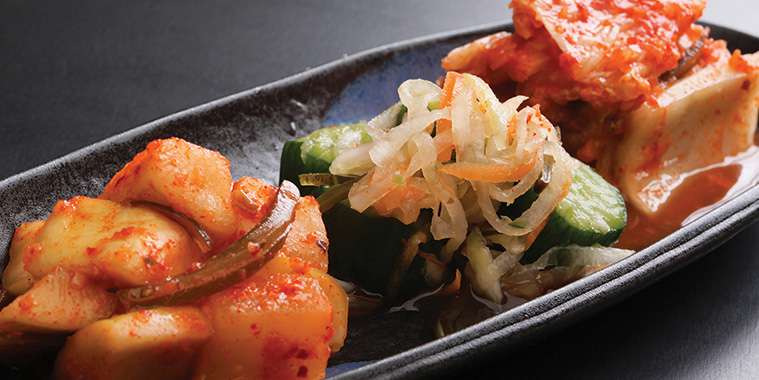In recent years, many of us have found new joy in the kitchen. For some, spending more time at home has meant experimenting with new cooking techniques and recipes.
Whether misadventures with baking bread, or if take-out meals were more your style, one of the top eating trends has been naturally fermented food. That includes treats like kimchi, sauerkraut, kombucha drinks or even sourdough bread. The fermentation process to make these foods has been practiced around the world for generations.
But what makes fermented foods so popular? According to registered dietitian Abbey Sharp, “Fermentation provides probiotics or ‘good’ bacteria, which are great for supporting our immune systems and for regulating digestion. Fermentation is also known to bring out rich and delicious flavours.”
Naturally fermented sourdough bread is a great source of fermented flavour in this elevated lunch or brunch sandwich, and paired with a thirst-quenching locally-produced kombucha, it’s perfect for your next gathering.
Chevre, Pear & Prosciutto Sandwich
Prep time: 10 minutes Cook time: approx. 1 hour
Serves: 6
Ingredients:
Caramelized Onions:
2 tbsp (30 ml) butter, divided
1 tbsp (15 ml) olive oil
3 large onions, thinly sliced
2 tsp (10 ml) honey
Salt and pepper
Sandwiches:
1 loaf (12 slices) Stonemill Bakehouse Authentic Sourdough Rye Multigrain Bread or any hearty sourdough or sprouted grain bread
1/2 cup (125 ml) chevre, softened
1/4 cup (60 ml) cream cheese, softened
2 red pears, thinly sliced
12 thin slices prosciutto
Balsamic glaze, for serving
Directions:
1. In a large skillet, heat the oil and butter over medium low heat until melted.
2. Add the onions and cook until caramelized and golden, about 45-60 minutes.
3. Add the honey and a pinch each of salt and pepper and cook another 1-2 minutes. Set aside.
4. In a bowl, mix together the chevre and cream cheese.
5. For each sandwich, add 2 tablespoons of the cheese mixture onto one slice of bread. Add 4 thin slices of pear, two slices of prosciutto and top with a generous spoonful of caramelized onions. Drizzle with a tablespoon of balsamic glaze.
6. Serve with hibiscus and rosehip kombucha.
Visit stonemillbakehouse.ca for more information and great recipes.
Tasty Kimchi
Kimchi is fermented napa cabbage made with Korean flavours. Kimchi is spicy and umami and sour — and perfect for adding pizzazz to everything from fried rice to poutine to noodles or tacos. There are also other variations of this. My grandmother used to make a zesty European version of it using carrots and green peppers that was beyond scrumptious!
Prep Time: 30 minutes Cook Time: 4 days
Yield: 8 cups
Ingredients:
2 pounds napa cabbage, cored and cut into 1-inch pieces (one large cabbage)
¼ cup sea salt (60 grams)
2 cups daikon radish and/or carrot, cut into matchsticks
1 bunch scallions, cut into 1-inch pieces
1 tablespoon fresh ginger, sliced
6 cloves garlic, whole
1 shallot, quartered (optional)
2–6 tablespoons red pepper flakes (use 4 for medium spice, all 6 for hot)
2 tablespoons fish sauce or use shrimp paste, miso paste or soy sauce, plus more to taste
2 teaspoons sugar (or an alternative like honey or agave syrup)
Directions:
1. Salt the cabbage (6-8 hours): Reserve 1-2 outer leaves of the napa cabbage and refrigerate for later use (wrap in plastic). Cut the remaining cabbage and place it in a large bowl with the salt and toss. Add enough cool water to cover the cabbage and stir until salt is dissolved. Keep the cabbage submerged with a plate over the bowl and let stand at room temperature 6-8 hours (giving a stir halfway through) or overnight.
2. Drain the cabbage, saving the brine. Rinse the cabbage lightly, drain, squeeze out any excess water, or blot with paper towels, and place it back in the bowl, adding the daikon radish and scallions.
3. Make the paste: Place the ginger, garlic, shallot, red pepper flakes, fish sauce (or alternatives) and sugar in your food processor, pulsing until it becomes a thick paste.
4. Massage: Scoop the paste over the cabbage and using tongs or your hands (wear gloves!), mix and massage the vegetables and the red pepper mixture together well until evenly coated.
5. Pack the cabbage into a large 2-quart jar (or two 1-quart jars) or crock, leaving 1-2 inches room at the top for juices to release. Add a little of the reserved brine to just cover the vegetables, pressing them down to submerged. Place the whole cabbage leaf over top, pressing down, to help keep the kimchi under the brine. You can also use a fermentation weight placed over top of the whole leaf to keep it submerged. If cabbage touches any air, it will mold, so the leaf or weight helps keep it submerged.
6. Ferment 3-4 days: Cover loosely with a lid (allowing air to escape) and place the jar in a baking dish or bowl to collect any juices that may escape. But you want to keep as much of the tasty juice in the jar, so don’t overfill. Leave this somewhere dark and cool for 3 days. A basement or cabinet in the pantry or kitchen away from appliances works best.
7. Evening of day 3: Check for fermentation action or bubbles. Tap the jar and see if tiny bubbles rise to the top. Overflow also indicates fermentation. If you see bubbles, it’s ready to store in the refrigerator where it will continue to ferment and develop more flavor slowly. For a softer, tangier kimchi, you can continue to ferment for 3 more days or longer. If you don’t see any action, it just may need a few more days. Be patient.
8. Refrigerate after you see bubbles. The kimchi won’t achieve its full flavor and complexity for another 2 weeks as it slowly continues to ferment. The longer you ferment, the more complex and tangy the taste. If you like a fizzy brine, tighten the lid, burping every week or so. If you don’t want to think about it, give the lid one loose twist, so it’s on there, but gases can escape.
9. Kimchi will keep fresh for months in the fridge.
— DG/NewsCanada.com



